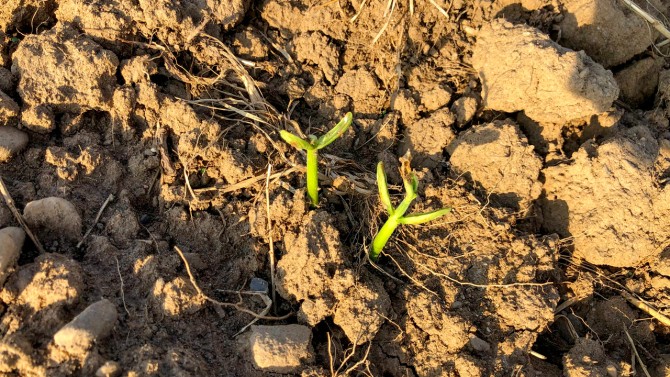New Cornell research offers alternatives to a class of insecticides that has devastating ecological impacts, especially to pollinators, beneficial insects and aquatic invertebrates. A paper in Crop Protection published online on August 5 examines a number of alternatives to neonicotinoids (neonics) that might work for farmers who grow large-seeded vegetable crops such as snap bean, dry bean and sweet corn.
"We wanted to find other options for growers to protect their vegetable crops from major pests. The impetus was to identify new products including those in the registration pipeline," said Brian Nault, corresponding author on the paper and professor and program leader in the Department of Entomology at Cornell AgriTech in the College of Agriculture and Life Sciences (CALS). "My program has shifted in recent years and has focused on this major issue."
Snap bean seedlings, shown here damaged by seedcorn maggot, are among the crops the Cornell researchers used in their study of eco-friendly insecticides.
The task has not been easy, he added. "Insecticides kill insects, so it's a tall order to find those that kill the pests but have minimal effects on pollinators and other beneficial insects."
The race to find alternatives to neonicotinoids is urgent, Nault said, because the Birds and Bees Protection Act in New York state is phasing out the sale, distribution or purchase of certain neonicotinoid-treated corn, soybean or wheat seeds starting in the next few years. Governor Kathy Hochul signed it into law, the first of its kind in the country, in 2023, saying that it "underscores our commitment to fostering a thriving ecosystem while we prioritize sustainable farming and agricultural practices."
Research shows neonics have made U.S. agriculture more harmful to insects, and the Environmental Protection Agency determined that neonics likely jeopardize the continued existence of more than 200 threatened and endangered species.
The implementation of the new law allows sufficient time for innovative research on alternatives and the development of more cost-effective products that are less harmful to the environment, Nault said.
The researchers' comprehensive, multi-state and multi-year study demonstrated that non-neonicotinoid insecticides varied in their ability to protect large-seeded vegetable crops against a common pest called seedcorn maggot, said Leonardo Salgado, first author and Ph.D. candidate in the graduate field of entomology.
The researchers conducted field studies from 2021 to 2024 across Delaware, Minnesota, New York, Washington and Wisconsin. They compared protection of vegetable crops from seedcorn maggot using standard neonicotinoid seed treatments, thiamethoxam and clothianidin, with non-neonicotinoid alternatives including spinosad, cyantraniliprole, chlorantraniliprole, isocycloseram and tetraniliprole. They also compared the risk of these alternative insecticides to workers, consumers and the environment using the Environmental Impact Quotient (EIQ) developed by Cornell University's Integrated Pest Management Program.
"Some of the alternatives we found are safer for bees and pollinators, but not as good at controlling seedcorn maggot," Salgado said. "The alternatives we are finding may not be a one-solution-fits-all, and we need to supplement these new solutions that we have with other strategies."
They found that cyantraniliprole and spinosad seed treatments in snap bean performed as well and occasionally better than the neonicotinoid standard, thiamethoxam. None of the alternative insecticide seed treatments in dry bean provided consistent and reliable protection against seedcorn maggot compared with neonics. But the big triumph was that five alternative seed treatments (chlorantraniliprole, cyantraniliprole, isocycloseram, spinosad and tetraniliprole) proved as effective as standard neonics for sweet corn.
"Sweet corn is a pretty big crop in New York state," Nault said. So there is good news about alternatives for sweet corn, less so for dry beans and snap beans, he said. For all of the alternative pesticides, their research shows, supplemental options may be necessary to cover additional pests.
"For many vegetable crops, farmers could replace the neonic at planting but may need another pesticide later in the season," Nault said. Other important factors will need to be considered before adopting non-neonicotinoid alternative seed treatments. For example, many are not yet approved for commercial use on these specific crops, and the cost of these newer products will undoubtedly be more expensive than neonicotinoids.
This multi-state study, led by Cornell researchers and their collaborative team, provides crucial data to support future registrations of these non-neonicotinoid options. Their findings are vital for diversifying the insecticide classes used in these crops, particularly by incorporating active ingredients that function differently, can help delay the development of insecticide resistance and improve the long-term sustainability of pest management programs in large-seeded vegetable crops across North America.
Funding for the study came from Cornell IPM Program, the New York State Agriculture and Markets, the Washington State Commission on Integrated Pest Management, the Delaware Department of Agriculture Specialty Crop Block Grant and the Midwest Food Products Association.







